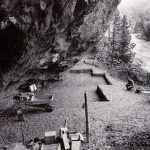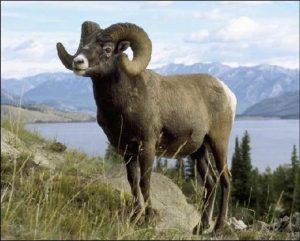Ten horses for one bow? This at a time when one horse would be the dowry for a wife. This at a time when capturing just one horse proved your mettle as a warrior. Ten horses for one bow seems outrageous. Yet this was the price of Sheep horn bows in the Rocky Mountains. Although they were rarely for sale, a trapper in the early 1800’s, George Belden said that after considerable pleading he was able to buy one for the huge sum of thirty-two dollars in gold.
The highest quality bows in the American West were made by the Sheepeater Indians, a group related to the Shoshone.
Indians had been eating Bighorn sheep in the west for Millenia. Excavations from Mummy Cave on the Shoshone River in East Yellowstone go back 9000 years. Excavations in this dry cave go down 33 feet (approximately ten metres) with the deposits at that depth being dated at 9000 years Before Present. The excavations indicate continual usage of this cave from then until the present. Bighorn sheep bones were by far the most represented in the layers, which held very few elk bones and absolutely no moose or bison bones. Bighorn sheep bones outnumber deer ones ten to one.
So back to the bows – these were made from Bighorn sheep horn. A pair of horns was softened in hot water – typically in a hot spring, of which there a many through the slopes of the Rocky and other mountain ranges. Yellowstone, of course, is famous for its hot springs, and for Darwin Award candidates falling in and dying a scalding death. At least 22 white people have died in springs since the Yellowstone’s designation as a National Park. (More information in this short article) Dipping horns in these hot springs is no safe thing. And it was not just dipping, the horns had to be soaked in very hot water for up to three days.
Once softened the horns were shaped and straightened, then the pair spliced and glued together. The glue was made from boiling down hide, animal skin. To strengthen the spliced joint and to give the bow the elasticity it need animal sinew – usually from the whole length of the backstrap (muscle that runs the length of the spine).
A description from a fur trader, Nathaniel from 1834 supports this: they are about two feet ten inches (800mm) long . . . are of two parts, spliced in the centre by sturgeon glue, and deer sinews . . . brought into shape by wetting and heating and worked smooth by scraping with sharp stones . . . the sinews, nearly entire, are strongly glued . . . these sinews cover the whole width of the back of the bow. As a matter of ornamentation the skin of a snake, commonly . . . rattlesnake, is glued to the back of the bow.
These sheep horn bows had potentially very high draw weights, up to 100 pounds (45kg.). Although it is thought they were usually set at around sixty pounds. This was because they were hard to hold steady at high draw weights. Being short bows they were ideal for shooting from horses. Reputedly they could and did shoot right through bison.
For information on making these bows see the links below. The first is from Tom Lucas, a lifetime cowboy from Lander, Wyoming.
http://www.primitivearcher.com/smf/index.php?topic=53905.0


